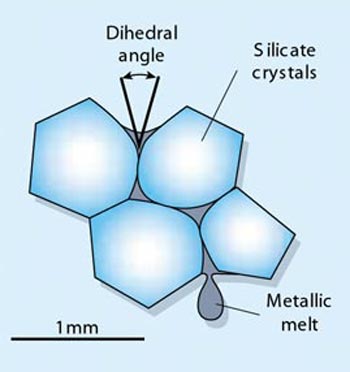The Earth is thought to be made of a metallic core surrounded by a silicate shell, but the origins of this structure is one of the outstanding unanswered questions in planetary science. Researchers at the Institute for Study of the Earth’s Interior at Okayama University in Japan have now used electrical conductivity measurements to show that the Earth may have formed from rocky bodies that had already separated into mantle and core (T Yoshino et al. 2003 Nature 422 154).

It is believed that core formation occurred when the Solar System was very young – less than 30 million years old. The Earth formed from a cloud of dust and gas, and material began to come together to form kilometre-sized planets known as “planetisimals”. These planetisimals rapidly joined together to form larger planets, thousands of kilometres in diameter. Researchers think that the Earth had already formed a core at this early stage (figure 1).
The Earth’s upper mantle is mostly made up of silicon oxide or “silicate” and a mixture of iron and magnesium oxide. At high temperatures, a metallic melt containing iron forms between grains of the silicate crystals because it has a lower melting point. For this metal to form a planetary core, it must separate from the silicate matrix and move through it (figure 2).
Tomoo Katsura and colleagues measured the electrical conductivity of the silicate and iron melt at temperatures of 1300oC and pressures of 3 gigapascals. These conditions correspond to those found about 100 km below the surface of the Earth. The conductivity of iron compounds is much larger than that of silicates, which allows small amounts of the metal alloy to be detected.
The researchers found high conductivities in their samples – corresponding to about 6% by volume of iron melt – which remained even after the temperature was reduced. The molten iron creates “connective” channels in the silicate allowing the metal to separate out.
The high temperatures needed to melt the iron may have come from the heat released from the radioactive decay of short-lived isotopes that were present in the early Solar System. If the high conductivities observed in the experiment correspond to the flow of metal through the silicate, then the separation of core from mantle could have occurred very quickly – in less than 3 million years – in small planetisimals with radii of less than 30 km.




